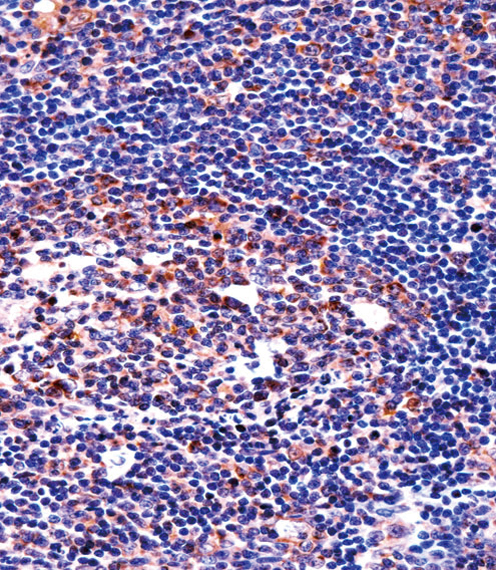

| WB | 1/1000 | Human,Mouse,Rat |
| IF | 咨询技术 | Human,Mouse,Rat |
| IHC | 1/100-1/500 | Human,Mouse,Rat |
| ICC | 技术咨询 | Human,Mouse,Rat |
| FCM | 咨询技术 | Human,Mouse,Rat |
| Elisa | 咨询技术 | Human,Mouse,Rat |
| Aliases | Nicotinate-nucleotide pyrophosphorylase [carboxylating], Quinolinate phosphoribosyltransferase [decarboxylating], QAPRTase, QPRTase, QPRT |
| Entrez GeneID | 23475 |
| WB Predicted band size | 30.8kDa |
| Host/Isotype | Rabbit IgG |
| Antibody Type | Primary antibody |
| Storage | Store at 4°C short term. Aliquot and store at -20°C long term. Avoid freeze/thaw cycles. |
| Species Reactivity | Human |
| Immunogen | This QPRT antibody is generated from rabbits immunized with a KLH conjugated synthetic peptide between 206-234 amino acids from the C-terminal region of human QPRT. |
| Formulation | Purified antibody in PBS with 0.05% sodium azide. |
+ +
以下是关于QPRT(喹啉酸磷酸核糖转移酶)抗体的3篇参考文献示例,包含文献名称、作者及简要摘要概括:
---
1. **文献名称**:*Development and characterization of a specific antibody for quinolinic acid phosphoribosyltransferase (QPRT) in human brain tissue*
**作者**:Schwarcz R, et al.
**摘要**:该研究开发了一种高特异性的人源QPRT多克隆抗体,并验证了其在人脑组织中的免疫组化及Western blot应用。研究揭示了QPRT在神经元中的分布特征,并探讨其在神经退行性疾病中可能的病理作用。
2. **文献名称**:*QPRT-mediated NAD+ synthesis is critical for macrophage function in inflammation*
**作者**:Minhas PS, et al.
**摘要**:研究通过QPRT抗体检测巨噬细胞中QPRT蛋白表达,发现QPRT通过调节NAD+代谢影响炎症反应,为靶向QPRT的免疫治疗提供了实验依据。
3. **文献名称**:*Immunohistochemical analysis of QPRT expression in renal cell carcinoma and its prognostic significance*
**作者**:Saito K, et al.
**摘要**:利用QPRT抗体对肾癌组织进行免疫组化分析,发现QPRT低表达与患者不良预后相关,提示QPRT可能作为潜在的肿瘤标志物或治疗靶点。
---
以上文献涵盖了QPRT抗体的开发、功能研究及临床病理应用,具体文献信息需根据实际数据库检索结果调整。建议通过PubMed或Web of Science以“QPRT antibody”为关键词进一步筛选近年研究。
The QPRT (quinolinic acid phosphoribosyltransferase) antibody is a tool used to study the enzyme QPRT, which plays a critical role in the kynurenine pathway of tryptophan metabolism. QPRT catalyzes the conversion of quinolinic acid (QUIN) into nicotinamide adenine dinucleotide (NAD+), a vital coenzyme in cellular energy production and redox reactions. QUIN, a neuroactive metabolite, acts as an endogenous excitotoxin at NMDA receptors, and its dysregulation is implicated in neurodegenerative disorders like Alzheimer’s disease, Huntington’s disease, and HIV-associated neurocognitive impairment.
QPRT antibodies are widely employed in neuroscience and immunology research to detect QPRT expression in tissues or cell models, helping to elucidate its role in neuroinflammation, neurotoxicity, and NAD+ biosynthesis. They are utilized in techniques such as Western blotting, immunohistochemistry, and immunofluorescence. Studies using these antibodies have revealed altered QPRT levels in neurological diseases, suggesting its potential as a therapeutic or diagnostic target.
Commercial QPRT antibodies are typically raised against specific epitopes of human or mouse QPRT proteins, validated for specificity via knockout controls or siRNA silencing. Researchers often use them to explore metabolic cross-talk between immune and neural cells, particularly in contexts like microglial activation or neurodegenerative disease models. Proper validation remains essential due to occasional cross-reactivity with related enzymes in the kynurenine pathway.
×